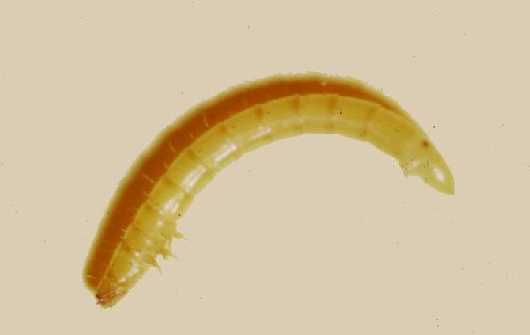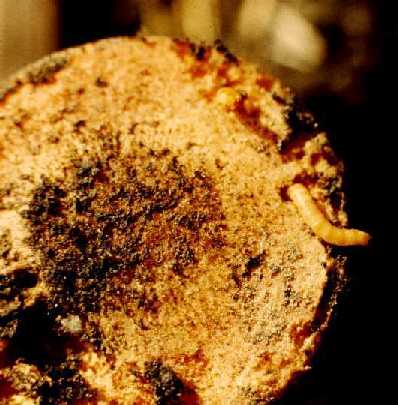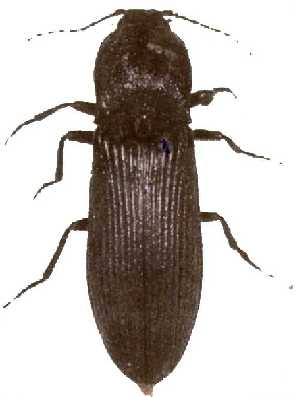Managing wireworms in vegetable crops
Learn the symptoms, biology, monitoring and management of wireworms in vegetable crops.
Wireworms, which are the larvae of click beetles (Family Elateridae) have become an increasingly common pest of many vegetable crops in recent years. Carrots, cucurbits, rutabagas, onions, sweet corn, potatoes, sugarbeets, beans and peas have seen increasing losses to this pest in some areas.
Identifying wireworms
Wireworms are easy to identify once observed a few times. This larvae is unlike most larvae because it is hard-bodied and darker coloured than most maggots or grubs. Wireworms are cylindrical and vary in colour from tan to copper. They range in size from 1–4 cm when mature. (See Figures 1 to 3.) The adults are elongated, hard-shelled, dark-coloured beetles which usually have a tapered body and range from 1–3 cm long. When captured and placed on their back, the adult wireworm flips itself right-side-up by flexing the middle part of its body. This habit led to the term 'click beetles'. (See Figure 4)
There are many species of wireworm in North America however Limonius, Ctenicera and Agriotes species cause the most damage to crops in Ontario. Many other species are harmless to agricultural crops.




Biology
The life cycle of wireworms ranges from 2–6 years depending upon species and location. All life stages (adult, larva, pupa) can overwinter and in most infested fields different larval stages can be found. Adults mate and females lay eggs around the roots of grasses and grains. The larvae of the click beetles are the damaging stage, feeding on roots and seeds in the soil for up to 6 years. Larger seeds may be hollowed out and plants attacked during emergence or soon after transplanting are often killed. Damage to root crops such as carrot and rutabaga closer to harvest can reduce the marketability of these crops and may also predispose them to secondary bacterial infections.
Wireworms move up and down in the soil profile in response to changes in soil temperature and moisture. During the growing season, the wireworms move up into the top few inches during the spring when soil temperatures reach approximately 10°C and remain there as long as temperatures remain near 26°C. If temperatures exceed 26°C or soil conditions become very dry, wireworms may burrow as deep as 60 cm (24 in.).
Last instar larvae form earthen pupal cells and either pupate immediately or overwinter in these cells as larvae and pupate in the spring.
Monitoring
Wireworms are usually most severe in fields that have been planted to grasses, grass-based pasture or alfalfa-based pasture that has had many grassy and broadleaf weeds. Pure alfalfa will not increase wireworm populations. Some vegetable crops like carrots and potatoes however may also help to increase the wireworm population. Heavy, wet soils also seem to favour more wireworm problems. Wireworm populations must be monitored prior to planting a susceptible crop, so the first step is to know the field cropping history.
Sampling for wireworms can be done in the fall before the first frost when the larvae start to move down or in the spring when soil temperatures have warmed to approximately 8°C. There are various methods to assess the level of wireworms in soil. Taking soil samples at random from as many sites in the field as practical is recommended. Each sample should represent a similarly sized area i.e. 1 square foot, 6 in. (15 cm) deep. The soil can be sifted with ¼ in. hardware cloth to reveal the wireworms.
Wireworms can also be attracted to bait stations. Whole carrots buried 3 in. (8 cm) deep at 10–20 marked sites throughout the field and retrieved in 2–3 days can give a relative measure of the threat from wireworms. Another bait system uses several ounces of coarse whole-wheat flour or rolled oats or a mixture of untreated corn and wheat seed placed into a fine, mesh pouch and buried 6–12 in. (15–30 cm) deep. Bury the pouches with soil but do not pack down. Cover the bait station with black plastic and secure the edges of the plastic with soil. These stations should be placed 2–3 weeks prior to planting. Dig up the bait stations after 2–3 weeks and count the number of wireworms. Thresholds may vary, however a general guideline is 0.5–1.0 live wireworm per bait station. In some areas pheromone lures have been developed for monitoring the adult click beetles also. This is a more useful tool when the actual species of wireworms in an area needs to be determined since adult identification is simpler.
Management
No insecticides are available that provide control after the crop is planted. There are very few if any insecticides available for vegetable crops. Some crops such as corn, peas and beans have been able to use lindane treated seed, however this insecticide may not be available in the future. Orthene (acephate) is labeled for tomatoes as a transplant water treatment for soil insects including wireworm. Counter 15G (terbufos) is labeled for use on sweet corn and sugarbeets at planting time also. The fumigant Vorlex Plus is also labeled for most vegetable crops for wireworms, however widespread soil fumigation is not always a sustainable or economical management method.
The best management method is to avoid severely infested fields, however this is not always an option. Knowing the cropping history of fields and avoiding rotations with grasses and pastures will be helpful. During the growing season it also helps to control grassy weeds in the crop especially witchgrass or volunteer grains. Because wireworms have a wide host range, crop rotations are only moderately effective, however they can help reduce wireworm populations. Rotations with non-host crops such as onions, lettuce, alfalfa, sunflowers and buckwheat will reduce wireworm populations. Rotations with tomatoes, sugarbeets or corn may also help as these crops presently have labeled insecticides. Rotations with grains, grasses, pasture, carrots and potatoes must be carefully planned as these crops are prime targets for wireworms.
Managing wireworms requires regular and consistent monitoring and diligent field management as part of an ICM (Integrated crop management) program. For more information about managing wireworms, consult a crop specialist, your crop input supplier or processing company fieldpersons.